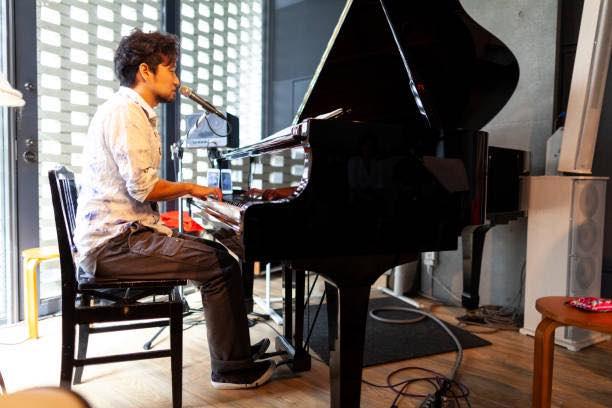Have you ever wondered what the difference is between a grand piano vs. baby grand? Maybe you’re just curious, or maybe you’re in the market for one. You have probably figured that they are different sizes, but there is actually plenty more to it than that! In this article, I’ll discuss the size and the mechanical differences, and explain how they affect the sound and feel of the piano.
The Grand Family
“Grand” is a term used to describe any style of piano where the strings inside are oriented horizontally, as opposed to “upright” pianos where they are oriented vertically. In the grand family, there are actually seven different size classifications. The size of a grand piano can vary depending on the classification. The “petit” grand is the smallest classification, which range from 4’5” to 4’11” in length. The next size up is the “baby” grand piano dimensions tend to be between 5’ and 5’5” feet long. The baby grand piano size make it the most popular for home use, since the sound quality is great and they are more affordable than the larger sizes.
When people talk about a “grand” piano, they are probably referring to the middle size of the grand family, the “professional” grand. The gran piano size between 5’9” and 6’2” in length. These are the style you might find at a music school or a university. The next size up, the “parlor” grand, is another popular choice for those looking for a rich professional sound and a magnificent living room centerpiece. The largest size of the grand family is the “concert” grand. These are the nine-footers, and they are commonly used alongside orchestras for piano concertos, and by professionals in larger music venues.
The Mechanics of the Piano
Did you know that the piano is technically a percussion instrument, like a drum set? Any kind of instrument where you hit something with something else is a percussion instrument, and that is exactly what happens inside the piano whenever you push one of the keys. Each key is connected to a hammer that strikes the strings of the piano to create sound.
Earlier, I mentioned that the strings of an upright piano are oriented vertically. That means that the hammers that strike the strings move horizontally, and they are held in place by a spring. In a grand style piano, the strings are oriented horizontally and the hammers lift up to strike the strings. Grand pianos rely on gravity to put the hammers back to their resting positions instead of springs. Without springs, the action that moves the hammer is less likely to break down over time. It also offers them a crisper, cleaner sound for repeated notes, and better responsiveness to the player.
Differences in the Sound
Grand pianos also have the option to lift up the lid and expose the strings, which greatly enhance the volume. This makes it ideal for larger spaces. The length of the strings also makes a difference with the volume, and contributes to the overall sense of warmth and richness of tone. While the refinement of the actions that control the hammers plays a role, it is the length of the strings is the most significant factor when comparing smaller and larger styles of grand piano.
The extra one and a half to three feet of length difference between a baby grand and a parlor or concert grand creates a significant difference in the sound. This has to do with an acoustical phenomenon called “overtones.” When you make a sound on an instrument, be it a string, a saxophone, or a singer, the most clear and immediate sound you hear is called the “fundamental” frequency, or tone. In addition to the fundamental tone, there are a series of higher frequencies sounding as well. These higher frequencies are the overtones, and they are what make the instrument or singer sound unique.
When someone refers to the “warmth and richness of tone” on the piano, what they mean is that the overtone series can be is more precisely attuned. Without getting into the nitty gritty of harmonic relationships, we can just keep in mind that the size of the strings on the piano affects overtone series. Baby grands have shorter and thicker strings than parlor or concert grands, which makes for a less ideal relationship between the fundamental tone and the overtone series.
When Choosing a Piano, Remember There are a Few Things to Consider…
I hope you found this interesting! If you are looking to purchase your own grand piano, or actually weighing the differences between grand vs. baby grand pianos for your own purposes, then remember that the best one for you will come down to three things: the purpose of the piano, the professionalism of the musician, and the size of the room. If you would like to learn more about your piano options for a more practical perspective, read my other article on Different Types of Pianos & How to Choose the Right One.
Lance Russell


